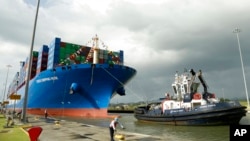China's efforts to build critical infrastructure across South and Central America are setting up Chinese military forces for a potential foothold on the U.S. doorstep.
China is "in the 'red zone,'" the commander of U.S. Southern Command said Friday, warning that many of China's economic initiatives can easily be flipped to support a Chinese military presence.
"They are on the 20-yard line to our homeland," SOUTHCOM General Laura Richardson told the Washington-based Center for Strategic and International Studies, using an American football analogy to illustrate how close China is to scoring on the United States.
"Or we could say they're on the first or second island chain to our homeland," she added.
Richardson, like other U.S. military officials, said Beijing has yet to establish an actual military base in the Western Hemisphere. But concerns have been mounting, especially following reports in June that China had upgraded an intelligence collection facility in Cuba in 2019 and could be looking to expand further.
"There's not a Chinese base yet," Richardson said. "But I see with all of this critical infrastructure investment with these BRI [Belt and Road Initiative] projects that there could possibly be some [bases] someday."
China’s embassy in Washington, however, dismissed such concerns as “lies and rumors … and slander.”
“To date, over three-quarters of countries around the world have joined this initiative, which has generated 420,000 jobs in these countries and helped more and more countries speed up economic growth,” embassy spokesperson Liu Pengyu told VOA via email.
“The BRI is well-received among the world most importantly because it is an initiative of extensive consultation, joint contribution and shared benefits,” Liu added. “China never imposes its will on other countries, nor does it slip any selfish geopolitical agenda into the initiative.”
But SOUTHCOM’s Richardson said there is a danger, pointing specifically to China's use of dual-use technologies to build deep-water ports along key waterways such as the Panama Canal and the Strait of Magellan, which could allow Chinese officials to quickly convert the facilities from civilian to military use.
Richardson also raised concerns about the proliferation of Chinese telecommunication infrastructure in South and Central America, noting five countries have already turned to China for high-speed, 5G mobile phone networks.
She said another 24 countries rely on China for 3G or 4G mobile networks, and many are being offered "almost zero cost" upgrades that would keep them reliant on Beijing for their communication needs.
And so far, Richardson noted, the U.S. has nothing better to offer.
"We are getting outcompeted by the Chinese right now," she said. "We have to be able to have alternative methods, alternative companies, alternative options for them [the Latin American countries] to be able to select."
This is not the first time SOUTHCOM's Richardson has warned about China's inroads into Central and South America.
During an appearance earlier this year at the Washington-based Atlantic Council, she spoke of "the tentacles of the PRC" reaching across the Western Hemisphere, noting 21 of 31 Latin American countries had signed on to Beijing's Belt and Road Initiative, with 17 welcoming Chinese investment in their deep-water ports.





